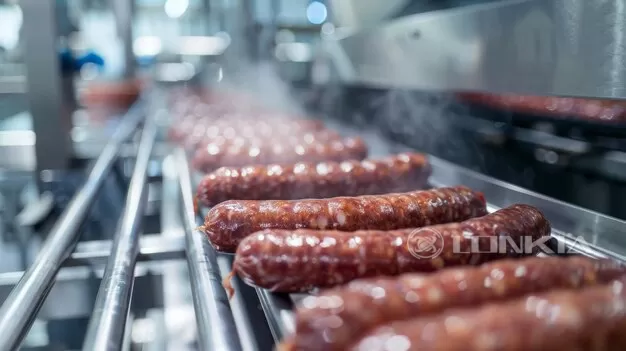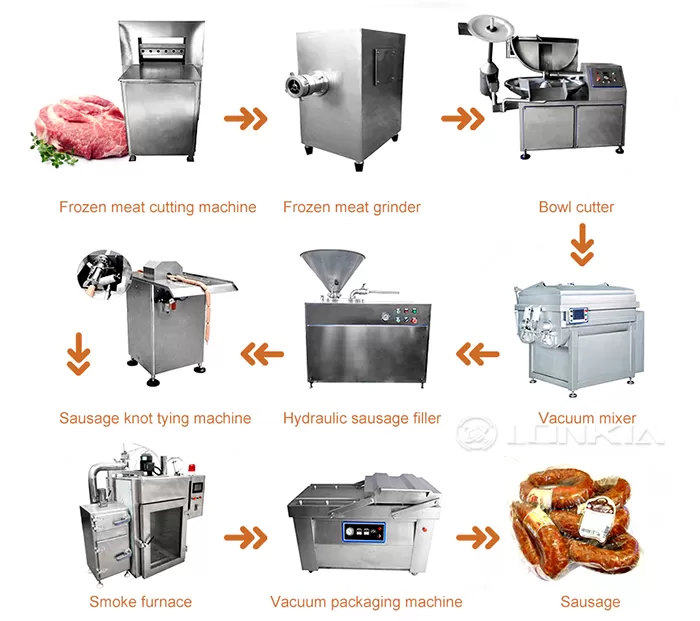Efficiency and productivity are critical for any food processing operation, and sausage production is no exception. With rising consumer demand and increasing competition, manufacturers must continuously optimize their sausage production lines to maintain quality, reduce costs, and maximize output.
In this blog, we’ll explore the best practices for enhancing productivity in sausage production, from streamlining workflows to adopting advanced automation solutions.

1. Optimize Workflow and Layout
A well-organized production line layout minimizes downtime, reduces unnecessary movement, and ensures a smooth flow of operations. Consider the following layout optimizations:
- Minimize bottlenecks by arranging equipment in a logical sequence.
- Ensure adequate space for raw material handling, processing, and packaging.
- Implement a linear workflow to prevent cross-contamination and delays.
- Use conveyor systems to transport materials efficiently.
By improving your production line's physical setup, you can reduce processing time and increase throughput.
2. Invest in Automation and Advanced Machinery
Automation is a game-changer for sausage production, significantly boosting efficiency while maintaining consistency. Upgrading to an automated sausage production line can lead to:
- Faster processing times with automated filling, linking, and cutting.
- Improved portion control to minimize product weight variations.
- Better hygiene and safety standards with less human intervention.
- Reduced labor costs by eliminating repetitive manual tasks.
At LONKIA Machinery, we offer fully automated and semi-automated sausage production lines designed to help manufacturers increase efficiency while maintaining product quality.
3. Standardize Ingredient Preparation and Mixing
Proper ingredient preparation is essential for achieving consistent sausage texture, taste, and quality. To improve efficiency:
- Use high-capacity meat grinders and bowl choppers to speed up processing.
- Implement precise weighing and portioning systems for consistent formulations.
- Utilize automated mixing and emulsifying machines to reduce processing time and improve ingredient distribution.
By streamlining ingredient preparation, you ensure uniform quality while reducing waste and processing delays.
4. Improve Sausage Filling and Stuffing Efficiency
Filling and stuffing are critical steps in sausage production. Using high-performance sausage stuffers and linking machines can significantly reduce downtime and improve speed. Consider the following enhancements:
- Use high-speed vacuum fillers to minimize air pockets and ensure uniform density.
- Opt for automatic sausage linking machines for consistent portion control.
- Choose the right casing material to optimize filling speed and texture.
Efficient filling processes not only boost productivity but also enhance product appearance and quality.
5. Optimize Cooking, Smoking, and Cooling Processes
The cooking, smoking, and cooling stages directly impact the flavor, texture, and shelf life of sausages. To improve efficiency:
- Use batch or continuous smoking chambers for even heat distribution.
- Ensure precise temperature control to maintain product consistency.
- Implement rapid cooling systems to reduce processing time and maintain product quality.
By optimizing thermal processing, you can enhance product quality while reducing production time.

6. Implement Quality Control and Food Safety Measures
Productivity is meaningless without quality. Maintaining strict quality control protocols ensures that sausages meet regulatory and consumer standards. Key strategies include:
- Using metal detectors and X-ray inspection systems to detect contaminants.
- Automating weight and portion checks to minimize product inconsistencies.
- Regularly sanitizing equipment to prevent bacterial contamination.
Adhering to HACCP (Hazard Analysis and Critical Control Points) standards ensures food safety and reduces the risk of recalls.
7. Train Employees and Implement Continuous Improvement Programs
Well-trained employees play a crucial role in boosting productivity. Regular training ensures that operators:
- Understand machine operation and maintenance procedures.
- Can quickly troubleshoot minor issues to minimize downtime.
- Follow hygiene and safety protocols to maintain product integrity.
Additionally, implementing continuous improvement programs such as lean manufacturing and Six Sigma can help identify inefficiencies and drive productivity gains.
8. Maintain and Service Equipment Regularly
Equipment breakdowns can cause costly downtime and production delays. To avoid this:
- Schedule regular maintenance to keep machines in top condition.
- Use predictive maintenance technologies to detect issues before failures occur.
- Keep spare parts in stock to minimize downtime in case of mechanical issues.
Preventative maintenance not only extends the lifespan of machinery but also ensures uninterrupted production.
Conclusion
Enhancing productivity in your sausage production line requires a combination of workflow optimization, automation, quality control, and effective maintenance. By investing in the right equipment, streamlining operations, and training employees, you can significantly improve output while maintaining high product standards.
At LONKIA Machinery, we provide state-of-the-art sausage production line solutions to help manufacturers achieve maximum efficiency, quality, and cost-effectiveness. Contact us today to learn how we can optimize your production process!
